Each winter, the frozen Zanskar river was the only access Zanskar Valley had to the outside world. It is today the setting for the renowned Chadar trek, which has brought in crowds and alongside, a host of problems. The final straw is the construction of a new road, which will bring an end to this traditional migration and a way of life.
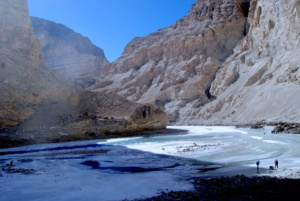
First published: https://www.thehindubusinessline.com/blink/takeaway/zanskar-valley-walking-on-thin-ice/article8309875.ece
Zanskar Valley: Walking on thin ice
Chadar, a frozen highway of sorts, is melting under the burden of tourism
Nasir Ahmed and Sonam Wangyal have lived separate lives in Leh and Tungri village in Zanskar Valley, respectively. Their homes nestle in the imposing mountains of the Zanskar range, a natural barrier, which is impenetrable in the winter months. However, for centuries now, the Zanskar river has provided a passage for this duo, as it has for the 15,000-odd residents of the Zanskar Valley.
The only approach road to Padum — the administrative capital of Zanskar — is via the Pensi La, about 250 km from Kargil. Every winter, this pass gets snowed out around November, isolating Zanskar from the rest of Jammu & Kashmir for the next five months.
It’s also the time the Zanskar river freezes, creating a frozen highway of sorts called the Chadar, which leads from the heart of the valley to the confluence with the Indus at Nimoo, 30-odd km from Leh. Since the time of the kings who ruled over Zanskar centuries ago, this route has been the only way in and out for the locals, as well as outsiders who wished to visit the valley. It is a cultural migration of sorts and is typical to this region.
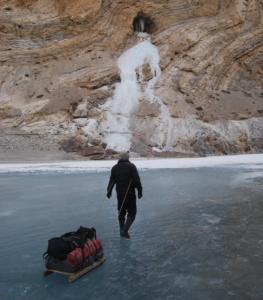
There’s a chance then, that Ahmed and Wangyal would have met each other at some point — quite by chance — thanks to trade that flourishes in this testing terrain. Ahmed is a veteran of the trekking business in Leh, with over three decades behind him, and each winter a foray into the Zanskar valley had an added benefit that he looked forward to.
“I would carry extra sugar as part of the trekking ration, whenever I visited Zanskar. For just a kilo or two, the locals would give me a goat, which provided enough food for the next few days,” he smiles.
Like Ahmed, Wangyal visited Leh every winter, with sacks of local cheese and butter from the dri — the female yak — which was relished in these parts, in addition to animal hide and curios. “It’s only now that money is involved. Back then, it was a simple barter for household essentials such as food and clothes, which was necessary to survive the winter months,” Wangyal says.
The stunning landscape, combined with the experience of walking on a frozen river that meanders through a steep gorge, was enough of a draw for trekkers, who made their way here despite the harsh conditions. The lack of trekking options in the winter months and the relative ease of the walk at an altitude of around 3,500m, same as Leh, made the Chadar Trek a must-do for travellers.
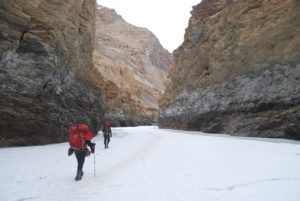
“Back in the day, there would be just a couple of groups that would venture on this trek. They were mostly foreigners who were out to explore this stretch, which was relatively unknown to the outside world,” Wangyal says. “It’s only in the last six or seven years that it has picked up among the Indian trekking community,” he adds.
While the growing number of trekkers augurs well for the locals, who make additional income as guides, cooks and porters, it is also endangering the very survival of this culture.
In January last year, a landslide on the Phuktal river in the upper parts of the valley led to the formation of a massive lake upstream. All treks in the region were subsequently cancelled. Consequently, the number of trekkers increased this year, and between early January and mid-February, the Chadar bore the brunt of 7,000-odd representatives of various agencies walking it.
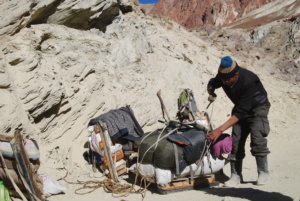
While the thickness of the ice is compromised by changing weather patterns, the unregulated load made things worse, and there were many patches where the river hadn’t frozen, forcing walkers to negotiate a tricky mountain path.
“Bombay ke fashion aur Zanskar ke Chadar ka koi bharosa nahin hain,” laughs Nima, from Phey village, who takes up portage in winter.
A trekker from Jalandhar, Satbir Singh was among those who bore the brunt of this overload. He broke a leg after the ice gave way in one section.
“There has to be a cap on the number of trekkers coming here each year. They also need to set up medical facilities in case of emergencies. I could manage only because I have some experience in mountaineering, but it’s something that the authorities must look into,” Singh says.
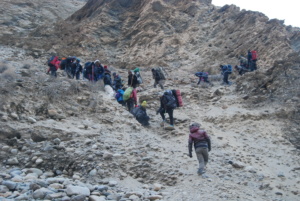
To regulate the flow, the local authorities had restricted the number of trekkers in each group to 10. But the rules were bent and more groups were added at the last minute. In fact crampons used by many trekkers worsened the condition of the ice, until a ban was implemented midway through the season.
The lack of sanitation facilities at the camping sites makes things worse, and it’s gradually transforming one of the most pristine landscapes into an eyesore.
The overcrowding and littered camps may, however, be the least of the threats to this natural wonder. A road is currently being built to provide round-the-year connectivity to the Zanskar valley, effectively bringing an end to this seasonal migration.
“The locals have demanded this road for a while now and even carried out protests in the past. In times of emergency, we have to use a helicopter service, which costs ₹1,500 a head and is unaffordable to most. This road will make life easier for us, but will also bring an end to a part of our culture,” says Tundup Dawa, a guide on the Chadar.
At the moment, a 40-km stretch between Dhar and Charakdo is missing, which will be completed in the next three years.
An Army depot is also likely to come up in the valley, making this a busy route in the years to come. A functional road will undoubtedly be a boon to the 82-odd villages of Zanskar, but the pollution generated will prove more detrimental to the formation of the Chadar, as also to the wildlife.
“The road construction has already driven the local wildlife away. This was prime snow leopard territory at one point, but today, they’ve gone higher up into the mountains,” says Jigmet Dadul, who works with the Snow Leopard Conservancy, India Trust, and has tracked the elusive cat over the last 18 years.
In his growing-up years, Wangyal was coached in lifesaving skills by his father — how to gauge the weather by looking at the sky, how to determine the thickness of the ice based on colour, and how to track wildlife and coexist with it.
Wangyal is unsure if the coming generations will have any use for such age-old wisdom. “It used to be an annual pilgrimage of sorts for us locals, and created livelihoods. Besides, there was something charming about this journey, a thrill each time around, despite the dangers we faced every year. It makes me sad that ours is perhaps the last generation that will be a part of it,” Wangyal says.